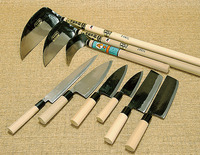

Total:131items
- Pottery & Porcelain (18)
- Lacquerware (4)
- Glasswork (2)
- Wood & Bamboo Work (19)
- Leather Work (1)
- Papermaking (13)
- Textile (20)
- Dyeing products (5)
- Masonry (1)
- Metal Work (11)
- Satsuma Suzuki: Satsuma Tinware
- Tosa Uchihamono: Tosa Blade
- Kaga Zougan: Kaga Inlay
- Akita Ginsen Zaiku: Akita Filigree
- Token: Japanese Sword
- Banshu-gama : Banshu Sickle
- Echigo-Sanjo Uchi Hamono: Echigo-Sanjo Blade
- Osaka Naniwa Suzuki: Pewter/Tin Ware
- Nakaniida-Uchihamono: Nakaniida Traditional Blade
- Higo-Tsuba
- Nokaji Hamono: Nokaji Blades
- Stationery (4)
- Accessory (4)
- Livingware (3)
- Toys & Entertainment (14)
- Interior (2)
- Other crafts (10)

 |
Main Production Site:Miyagi |
 《Characteristics》
《Characteristics》Nakaniida traditional blades are hammer-forged by blacksmiths one at a time. These blades are crafted using the karauchi method, a traditional forging technique that has been adopted from Japanese katana blade-making. There are no molds used; instead, iron and steel are heated in a furnace and made into shapes by hammering. It demonstrates authentic craftsmanship to create fine blades only by referencing samples of the desired shape. This involved crafting method is not suitable for mass production, so such items tend to cost relatively high. However, because this method is not limited by pre-set molds, it has the great advantage of allowing flexibly during the forging process, which makes for more diverse as well as unique products.
Nakaniida blades cut superbly. They are mainly used for sickles or hōchō Japanese-style kitchen knives. The light and well-balanced single-edged knives can be sharpened very easily, even by non-professionals. Nakaniida bladed sickles are also made with laminated steel, and have upward facing blades. This minimizes the wear and tear of the steel that would be caused by contact with the ground. Meticulously crafted, Nakaniida forged blades are widely used in a variety of cutting tools, and are praised for their excellent sharpness, durability, and outstanding ease of handling.
[Designated traditional craft by the governor of Miyagi Prefecture]
By courtesy of the Department of Commerce, Industry and Tourism, Kami-machi Town
Translation by Tomoko Yamamoto , Reviewed by Misa Imanaka
| Materials | Iron, steel, etc. |
|---|---|
| Crafting Processes | 【1】 Hagane-kiri, or cutting steel
The raw block steel is cut into an appropriate size. 【2】 Tansetsu, or combining hard and soft metals Iron and steel are heated in the fire bed (referred to as hokubo) , then combined by hammering. This process, wrapping the hard steel with the softer iron, reduces the possibility of the blade breaking when used. 【3】Karauchi hammering Heat the material produced in the preceding tansetsu process in the fire bed. The material, when turning red by the heat, is taken out of the fire bed and shaped by karauchi hammering. *In the general blade making process, karauchi sometimes means hammering the blade at normal temperature or slightly heated. This makes the metal particle finer and give more strength to the blade. Also called reikan-tanzō (cold forging). 【4】Yaki-ire, or hardening The hammered material is heated at the temperature higher than that of the tansetsu process, while kept moving so that it is heated evenly. This process makes the hatchet harder. 【5】 Grinding Whittle the surface of the blade to reshape, then grind it. 【6】Etsuke, or handle setting Set the blade to the handle to complete. |
| History | The origin of the Nakaniida blades dates back to about 360 years ago, when the swordmith FUNANO Gorobe started the production under the rule of Sendai domain lord DATE Masamune. Gorobe, a master of sword making, reportedly lived in Kami-machi Town (formerly called Nakaniida) and created the unique Nakaniida sickles utilizing the forging techniques of Japanese swords.
Therefore, Nakaniida blades have traditionally employed the karauchi hammering method. The technique is originally used for making Japanese swords and it is only employed by Nakaniida blades among other similar cutleries in Japan. The technique and art created by FUNANO Gorobe have been passed down from generation to generation until today. |
◆Exhibition / Showcase
For further information, contact:
Department of Commerce, Industry and Tourism, Kami-machi Town
Tel: +81-(0)229-63-6000
◆Event Information
Assistance needed? For inquiries in English:
JTCO Contact Form
Your inquiries will be forwarded by JTCO in Japanese to the organization you wish to contact.
*Please write the name of craft you wish to ask about.



